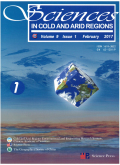- 钛学术文献服务平台 \
- 学术期刊 \
- 基础科学期刊 \
- 天文学、地球科学期刊 \
- 寒旱区科学(英文版)期刊 \
null
Comparison of sampling schemes for spatial prediction of soil organic carbon in Northern China
基本信息来源于合作网站,原文需代理用户跳转至来源网站获取
摘要:
Determining an optimal sample size is a key step in designing field surveys, and is particularly important for detecting the spatial pattern of highly variable properties such as soil organic carbon (SOC). Based on 550 soil sampling points in the near-surface layer (0 to 20 cm) in a representative region of northern China's agro-pastoral ecotone, we studied effects of four in-terpolation methods such as ordinary kriging (OK), universal kriging (UK), inverse distance weighting (IDW) and radial ba-sis function (RBF) and random subsampling (50, 100, 200, 300, 400, and 500) on the prediction accuracy of SOC estimation. When the Shannon's Diversity Index (SHDI) and Shannon's Evenness Index (SHEI) was 2.01 and 0.67, the OK method ap-peared to be a superior method, which had the smallest root mean square error (RMSE) and the mean error (ME) nearest to zero. On the contrary, the UK method performed poorly for the interpolation of SOC in the present study. The sample size of 200 had the most accurate prediction;50 sampling points produced the worst prediction accuracy. Thus, we used 200 sam-ples to estimate the study area's soil organic carbon density (SOCD) by the OK method. The total SOC storage to a depth of 20 cm in the study area was 117.94 Mt, and its mean SOCD was 2.40 kg/m2. The SOCD kg/(C?m2) of different land use types were in the following order:woodland (3.29)>grassland (2.35)>cropland (2.19)>sandy land (1.55).

推荐文章
期刊_丙丁烷TDLAS测量系统的吸收峰自动检测
带间级联激光器
调谐半导体激光吸收光谱
雾剂检漏 中红外吸收峰 洛伦兹光谱线型
不同盐度、温度及光照对漂浮浒苔生理生态的影响
浒苔
盐度
温度
光照
生理生态
期刊_联合空间信息的改进低秩稀疏矩阵分解的高光谱异常目标检测
高光谱图像
异常目标检测 低秩稀疏矩阵分解 稀疏矩阵 残差矩阵
内容分析
关键词云
关键词热度
相关文献总数
(/次)
(/年)
文献信息
| 篇名 | Comparison of sampling schemes for spatial prediction of soil organic carbon in Northern China | ||
| 来源期刊 | 寒旱区科学(英文版) | 学科 | |
| 关键词 | |||
| 年,卷(期) | 2020,(4) | 所属期刊栏目 | |
| 研究方向 | 页码范围 | 200-216 | |
| 页数 | 17页 | 分类号 | |
| 字数 | 语种 | 英文 | |
| DOI | |||
五维指标
引文网络
引文网络
二级参考文献 (59)
共引文献 (53)
参考文献 (46)
节点文献
引证文献 (0)
同被引文献 (0)
二级引证文献 (0)
1982(2)
- 参考文献(0)
- 二级参考文献(2)
1983(1)
- 参考文献(0)
- 二级参考文献(1)
1987(2)
- 参考文献(0)
- 二级参考文献(2)
1988(1)
- 参考文献(1)
- 二级参考文献(0)
1990(3)
- 参考文献(0)
- 二级参考文献(3)
1992(2)
- 参考文献(1)
- 二级参考文献(1)
1994(4)
- 参考文献(1)
- 二级参考文献(3)
1995(3)
- 参考文献(0)
- 二级参考文献(3)
1997(2)
- 参考文献(0)
- 二级参考文献(2)
1998(3)
- 参考文献(0)
- 二级参考文献(3)
1999(5)
- 参考文献(0)
- 二级参考文献(5)
2000(5)
- 参考文献(1)
- 二级参考文献(4)
2001(2)
- 参考文献(1)
- 二级参考文献(1)
2002(2)
- 参考文献(1)
- 二级参考文献(1)
2003(4)
- 参考文献(1)
- 二级参考文献(3)
2004(4)
- 参考文献(3)
- 二级参考文献(1)
2005(1)
- 参考文献(0)
- 二级参考文献(1)
2006(8)
- 参考文献(2)
- 二级参考文献(6)
2007(11)
- 参考文献(4)
- 二级参考文献(7)
2008(6)
- 参考文献(3)
- 二级参考文献(3)
2009(9)
- 参考文献(4)
- 二级参考文献(5)
2010(4)
- 参考文献(2)
- 二级参考文献(2)
2011(2)
- 参考文献(2)
- 二级参考文献(0)
2012(4)
- 参考文献(4)
- 二级参考文献(0)
2013(5)
- 参考文献(5)
- 二级参考文献(0)
2014(1)
- 参考文献(1)
- 二级参考文献(0)
2015(4)
- 参考文献(4)
- 二级参考文献(0)
2016(3)
- 参考文献(3)
- 二级参考文献(0)
2017(2)
- 参考文献(2)
- 二级参考文献(0)
2020(0)
- 参考文献(0)
- 二级参考文献(0)
- 引证文献(0)
- 二级引证文献(0)
引文网络交叉学科
相关学者/机构
期刊影响力
寒旱区科学(英文版)
主办单位:
中国科学院寒区旱区环境与工程研究所
科学出版社有限责任公司
出版周期:
双月刊
ISSN:
1674-3822
CN:
62-1201/P
开本:
出版地:
甘肃省兰州市东岗西路320号
邮发代号:
创刊时间:
语种:
eng
出版文献量(篇)
870
总下载数(次)
0
总被引数(次)
1072
期刊文献
相关文献
推荐文献
- 期刊分类
- 期刊(年)
- 期刊(期)
- 期刊推荐
力学
化学
地球物理学
地质学
基础科学综合
大学学报
天文学
天文学、地球科学
数学
气象学
海洋学
物理学
生物学
生物科学
自然地理学和测绘学
自然科学总论
自然科学理论与方法
资源科学
非线性科学与系统科学
寒旱区科学(英文版)2022
寒旱区科学(英文版)2021
寒旱区科学(英文版)2020
寒旱区科学(英文版)2019
寒旱区科学(英文版)2018
寒旱区科学(英文版)2017
寒旱区科学(英文版)2016
寒旱区科学(英文版)2015
寒旱区科学(英文版)2014
寒旱区科学(英文版)2013
寒旱区科学(英文版)2012
寒旱区科学(英文版)2011
寒旱区科学(英文版)2010
寒旱区科学(英文版)2009
寒旱区科学(英文版)2008
寒旱区科学(英文版)2020年第6期
寒旱区科学(英文版)2020年第5期
寒旱区科学(英文版)2020年第4期
寒旱区科学(英文版)2020年第3期
寒旱区科学(英文版)2020年第2期
寒旱区科学(英文版)2020年第1期

 免费查重
免费查重










